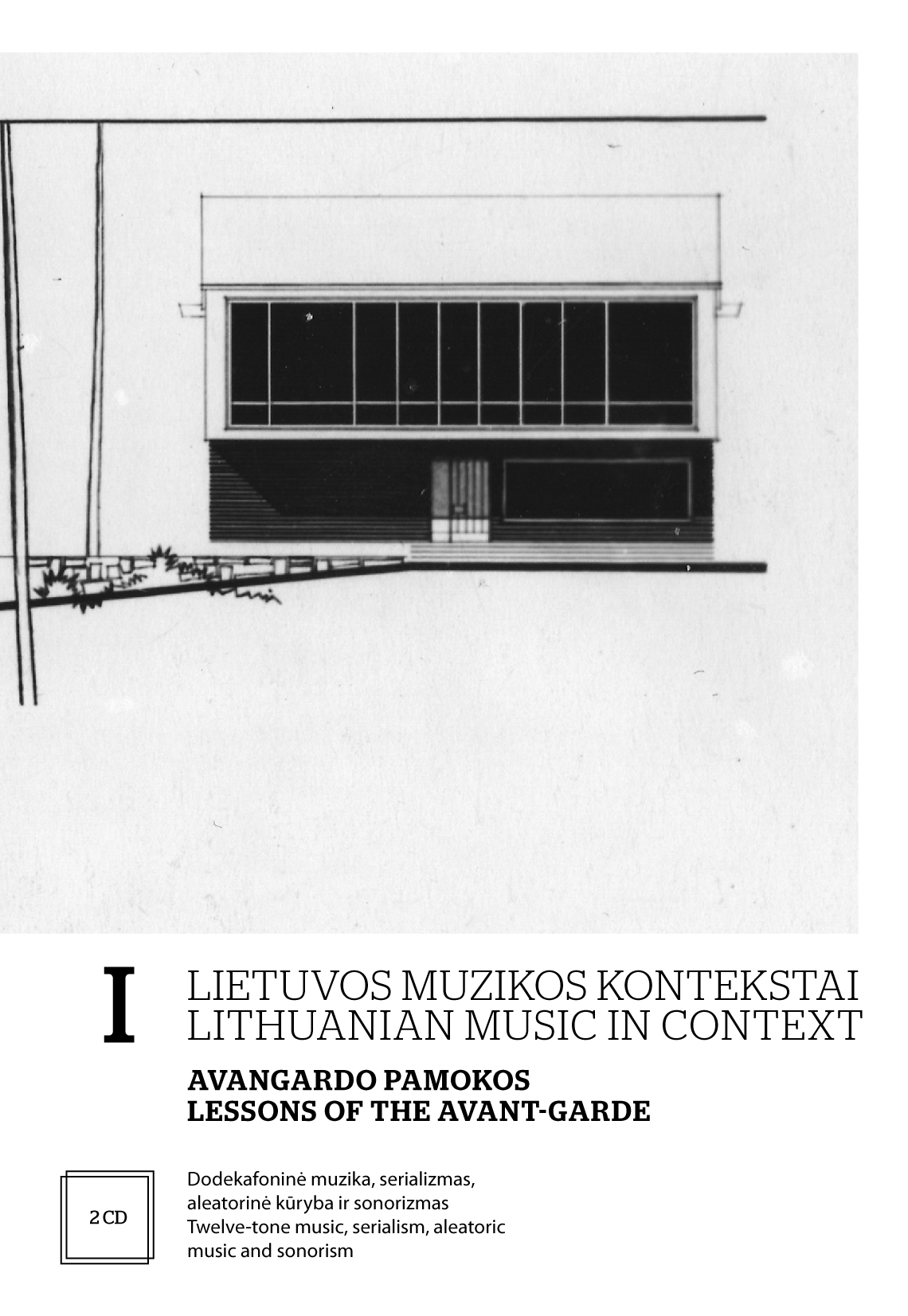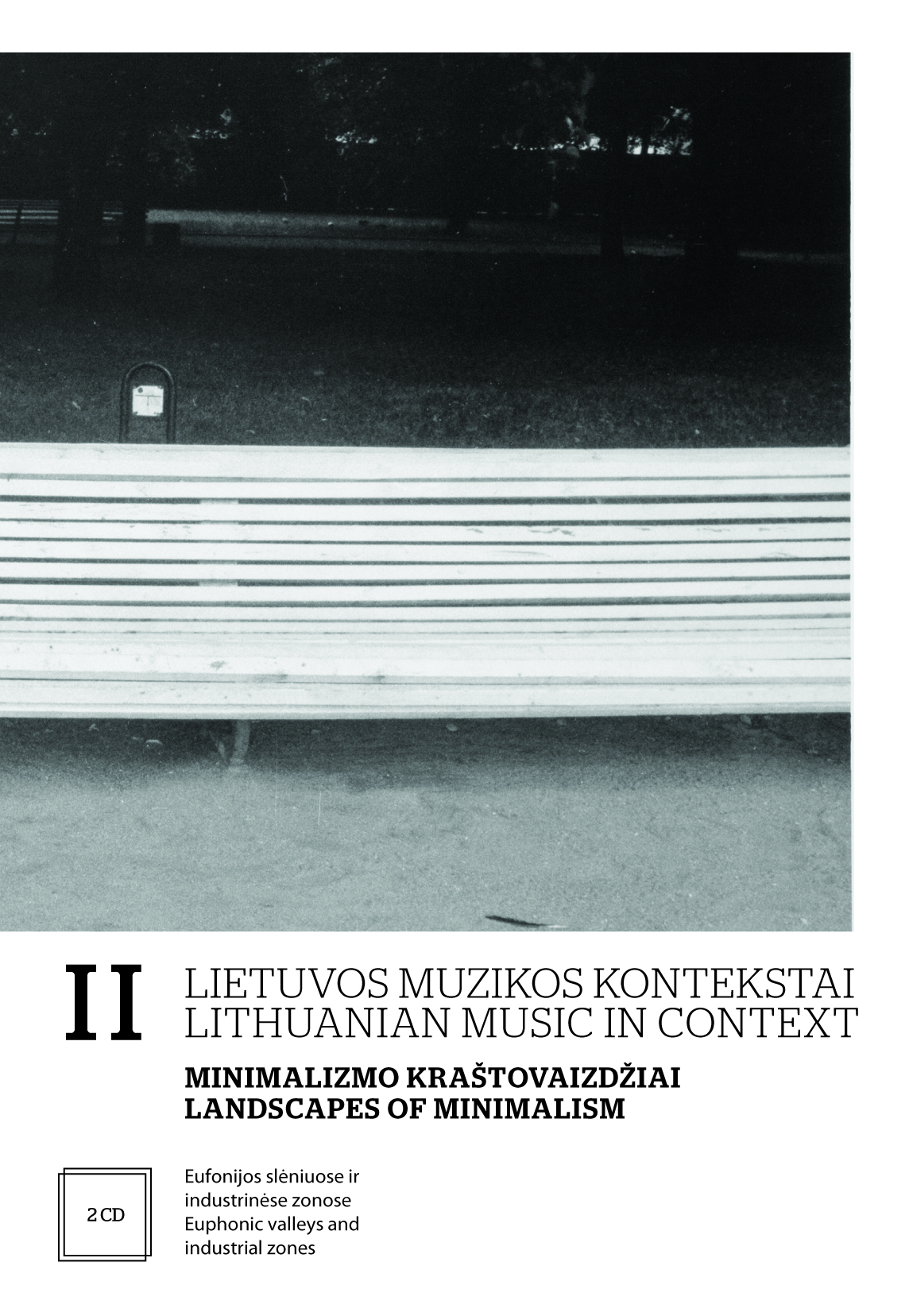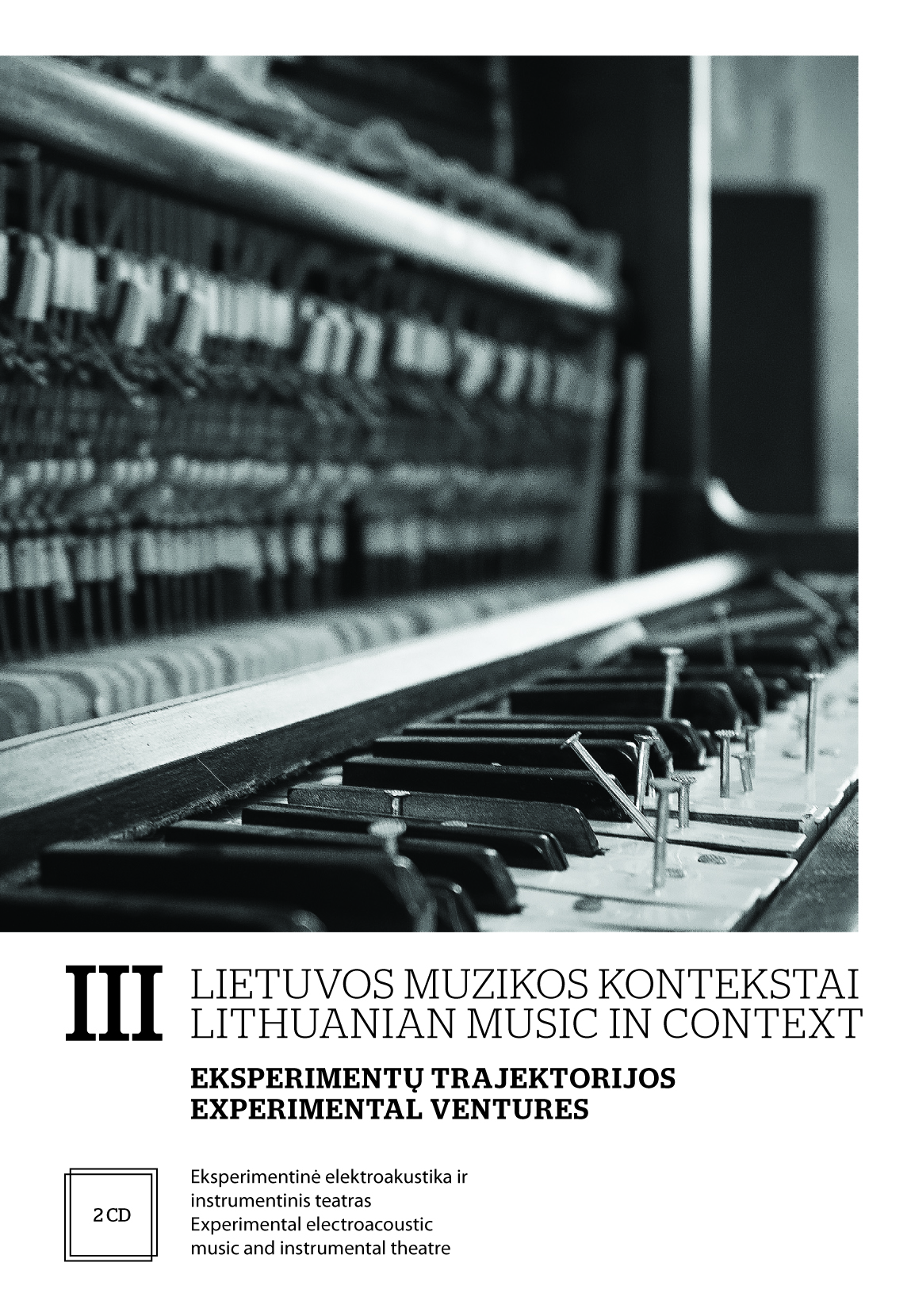is a series of anthologies that feature sound recordings and accompanying articles. The series consists of 3 volumes, 6 CDs, 45 sound recordings and 8 analytical essays; it encompasses 29 composers representing 5 different generations and more than 5 music trends that extend over 5 decades of the Lithuanian music history: from
, from dodecaphonic interventions to performative shock art, and from the historic articles on Lithuanian modern music during the Cold War era to contextual essays about the ‘post-’, the ‘inter-’ and the ‘electro-’ shapes of art music. In other words,
is a survey of the Lithuanian avant-garde, minimalism and experimental electronic music, their early manifestations and later metamorphoses, which mainly took place from 1960s to 1980s.
“Lessons of the Avant-Garde,” the first volume in the series, is a retrospective of the explorative music pertaining mostly to the 1960s and 1970s. It presents the music of those composers who undertook a ‘private courses’ in their explorations of the avant-garde techniques. The sound recordings in the compilation demonstrate some early avant-garde experiences and ventures (often pioneer in Lithuania) and are grouped into two categories: twelve-tone music and serialism (CD 1), aleatoric music and sonorism (CD 2). The immersion into these soundscapes calls for a different kind of listening – it asks to treat this music as a historic and perhaps even social phenomenon, while the creative, compositional, conceptual and aesthetic facets should be of the secondary importance. Such is the opinion of the ‘outside oberver’ Matthieu Guillot, whose
post scriptum recommendation discourages from focusing on a particular avant-garde technique (hitherto unused in Lithuania), and instead prompts to consider the socio-political consequences, which were imposed on such compositional techniques. In other words, this compilation is not so much a ‘lessons of the avant-garde’, but rather a ‘step-by-step history of the humankind,’ encompassing all its traumas, seizures, anxieties, breakdowns, obstacles, quarrels and illicit affairs.
It is possible that the notions of the first and the second avant-garde entered into the discourse on Lithuanian music culture when attempting to synchronize its course with the Western canon, juxtaposing the New Vienese School (Arnold Schoenberg, Alban Berg, Anton Webern, etc) against the Lithuanian interwar avant-garde (Vytautas Bacevičius,
Jeronimas Kačinskas), and the Darmstadt School (Pierre Boulez, Karlheinz Stockhausen, Luciano Berio, etc) against the Lithuanian avant-garde of the 1960s and the 1970s whose works are being introduced in this edition of the
Lithuanian Music in Context. It is unclear whether this juxtaposition is positive and constructive, whether the link exists, and if it is appropriate and valid? Perhaps the numeration of the Lithuanian avant-garde should not be a topic in music history, but rather a question in the field of cultural post-colonialism studies investigating the notions of universalism and binarism, that is to say, the view that the same models can be found and applied everywhere, and at the same time looking into the power struggle and the division between ‘us’ and ‘them,’ the ‘civilized core’ responsible for innovations and the ‘backward periphery’ that merely adopts them. One may only wonder what the history of Lithuanian modernity would look like if written from the perspective of decolonization, where the parallels between the ‘belated’, the ‘delayed’, ‘the-oddly-manifested’ and ‘the-never-happened’ peripheral avant-garde and the ‘central’ one are put to rest.
“Landscapes of Minimalism,” the second volume of the
Lithuanian Music in Context series presents a retrospective of Lithuanian minimalist music, which explores and looks back at the 1980s. In the process of compiling this collection of recordings and taking into account differences in their sound quality, style and aesthetic, two distinct types of minimalist ‘soundscape’ were encountered in Lithuanian music: an euphonic, naturalistic, inspiring a ‘bio-’ and ‘eco-’ nostalgia (CD 1); and a harsh, industrial, sometimes provoking ‘urban’ and ‘mechano-’ aggression (CD 2).
The onset of minimalism in Lithuanian music is normally dated back to 1978 when
Bronius Kutavičius presented the local artistic community with the work of staggering impact, the
Last Pagan Rites. However, an alternative version might be proposed as well, which takes the
Love Song and Farewell by
Mindaugas Urbaitis, composed in 1979, as the first Lithuanian artifact of minimalist music. Mindaugas Urbaitis’s conscious orientation towards minimalism of American extraction (while the emergence of minimalist features in the work of Kutavičius was more of a latent or ‘subconscious’ character) provides a valid argument enough for the inclusion of his piece among the harbingers of this trend in Lithuania.
Thus instead of the fragment from Bronius Kutavičius’s
Last Pagan Rites (his later ‘canonic’ work composed with minimal means was nonetheless included in this collection), CD 1 opens with the aforementioned composition by Mindaugas Urbaitis. The compilation proceeds with a couple of trendsetting pieces in the idiom of ‘post-romantic minimalism,’ created by
Vidmantas Bartulis and
Algirdas Martinaitis, and ends with the works by the proponents of post-war modernism –
Julius Juzeliūnas, Bronius Kutavičius and
Osvaldas Balakauskas. It should be noted, though, that Julius Juzeliūnas and Osvaldas Balakauskas worked in the territories of musical art quite remote from minimalism at the time, but were adventurous enough to make occasional digressions. These resulted in authentic testimonies to the rapid spread of minimalist trend and its coming into fashion in the local environment. In effect, compositions like
Spengla-Ūla by Osvaldas Balakauskas appeared to be exquisitely handcrafted models of minimalist ‘haute couture’ rather than mass-produced items of standard manufacture, dictated by the chase after the latest fads. Such singular works exerted a strong influence on the next generation of composers who made their debuts in the mid-1980s, including
Šarūnas Nakas,
Rytis Mažulis,
Ričardas Kabelis,
Nomeda Valančiūtė, and
Gintaras Sodeika.
CD 2 is dedicated entirely to the work of the latter generation of composers. Their instrumental pieces persistently evoke ‘mechanistic’ or industrial soundscapes, while vocal compositions seem to divert us to the more ‘humanised’ areas. By grouping these contrasting pieces together, we aimed to demonstrate different guises their music can take – the ‘edgier’ and the ‘softer’ in character – within the context of minimalism. Besides, it was intended to include here not only those of their works, which became their first ardent minimalist manifestos and enjoyed varying degrees of subsequent popularity (such as Rytis Mažulis’s Twittering Machine and Nomeda Valančiūtė’s Narcissus), but also exotic rarities like Šarūnas Nakas’s Ricercars and Gintaras Sodeika’s Katamorphosis, which are now regrettably part of the archive rather than that of the repertoire.
“Experimental Ventures”, the third volume in the series
Lithuanian Music in Context is dedicated to the fields of Lithuanian music history, which have not yet been thoroughly researched and documented – namely, the evolution of the local electro-acoustic music scene from the late 1970s to this day (CD 1) and experimental creativity in another related niche that might be tagged as ‘instrumental theatre,’ ‘performance art,’ ‘shock art,’ or in other similarly quirky terms (CD 2).
Unfortunately, it is impossible to begin our collection of archival recordings with the composition, which marks the beginning of electronic music in Lithuania – Outer Space composed by Vytautas Bičiūnas in 1961. The title and the year of composition clearly indicates the first manned spaceflight as its source of inspiration; while the structure and sound, as revealed by contemporary witnesses, was closely modeled on the German electronic compositions of the time, using sine wave generators to produce a sound collage on the cut and spliced magnetic tape. Vytautas Bičiūnas was better known to many as a musicologist and sound engineer (for decades he had been employed at the sound studio of the Lithuanian State Radio and Television and Vilnius Recording Studio of the All-Union Gramophone Record Company Melodiya, which provided him with the only available facilities for experimentation in the field of electronic music) and did not seem to care much about the preservation of his creations (or, at least, about his early experiments). Even if the fact of its existence is supported only by anecdotal evidence provided by the people who knew the composer and heard him demonstrate his pioneering Outer Space, these undocumented testimonies give a reason substantial enough to date the beginning of electronic music in Lithuania from 1961.
The present 2-CD set thus offers an overview of the documented history of Lithuanian electro-acoustic music. It opens with the two extant recordings from the end of the 1970s and tape compositions by Šarūnas Nakas and Tomas Juzeliūnas, witnessing the breakthrough of electro-acoustic creativity in the mid-1980s, and continues with a selection of pieces by composers from various generations, representing pluralistic tendencies of the internet age from the mid-1990s to the first decade of the 21st century.
Along with those ten electronic and electro-acoustic pieces, our anthology also features the soundtracks of ‘instrumental theatre’ pieces, mixed media performances and tape compositions, bearing traces of certain ‘theatrical’ or narrative elements. The upsurge of artistic activity in this field was provoked by the notable liberalisation of artistic expression in Lithuania in the second half of the 1980s when the last taboos have been transgressed by staging tantalising performances that combined music, theatrical action (with the participation of the audience), surrealistic sceneries, aromas, etc. and often involved paradox, absurd and grotesquery. Despite being stripped off their visual and performative elements, the extant soundtracks of these music-theatre pieces presented on CD 2 may be regarded as eloquent and valuable documents of that period (or, more precisely, of the ‘multidisciplinary’ turn in some composers’ work by the end of the 1980s).
Finally, the anthology would have been incomplete without the recording of Piano Piece #13 (Carpenter’s Piece) for Nam June Paik by George Maciunas, a Lithuanian born founder of the Fluxus movement. Even though it is not an electro-acoustic composition as such, it may be seen as a remote historical and ideological precursor (however distant in time and space) of the eccentric performances staged by Lithuanian composers at the end of 20th century.
MICL information
Translated by Vanda Gaidamovič and Veronika Janatjeva



